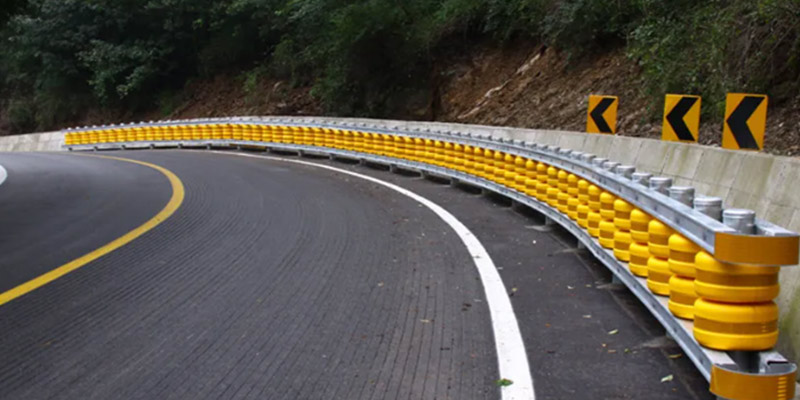Traditional rigid barriers (such as concrete barriers and standard corrugated barriers) exhibit significant limitations in traffic accidents. During collisions, these barriers offer rigid resistance, causing vehicles to rebound violently into oncoming lanes or roll over, thereby increasing the risk of secondary accidents.
Simultaneously, rigid collisions cause severe vehicle deformation, substantially increasing occupant injury and fatality rates. Furthermore, damaged barriers often require complete replacement, resulting in high maintenance costs and prolonged road closures.
As traffic volumes increase and vehicle speeds rise, traditional guardrails struggle to meet modern road safety requirements. Roller guardrails, as a new type of crash protection facility, precisely address these shortcomings through their unique rolling cushioning technology.
Rather than merely blocking vehicles, they dissipate collision energy using a “soft-meets-hard” approach. This makes them the preferred choice for safety upgrades on highways and hazardous road sections, with their core applications gaining widespread attention in transportation infrastructure development.

The core advantage of roller barriers lies in their freely rotating roller structure. Upon vehicle impact, the rollers rotate synchronously with the collision force, converting “rigid impact” into “rolling friction.”
This process rapidly disperses collision energy, preventing its concentration on specific vehicle components. It effectively minimizes vehicle deformation and reduces repair costs.
By buffering and dispersing collision energy, the barrier maintains the vehicle's directional stability. This prevents secondary injuries to occupants caused by violent rebounds or rollovers.
According to authoritative crash test data, under identical collision conditions, drum guardrails can reduce the impact force on occupants by 40%-60% and decrease severe injury rates by over 50%, providing critical protection for life safety.
When vehicles veer off lanes at high speeds, colliding with rigid traditional barriers can cause loss of directional control. The rolling characteristics of barrel barriers absorb energy while applying lateral guiding force to vehicles.
This “flexible correction” allows out-of-control vehicles to decelerate gradually along the barrier's path, gradually returning to the normal driving lane. This prevents vehicles from veering off the roadway or crossing into oncoming traffic.
On accident-prone sections like highway curves and long downhill slopes, a single collision mishandled can easily trigger chain-reaction crashes. Barrel barriers rapidly stabilize out-of-control vehicles, shortening accident response times.
Simultaneously, their guiding function reduces the risk of vehicles lingering in the roadway center, significantly lowering the probability of secondary accidents caused by following vehicles failing to avoid them—particularly effective during nighttime or adverse weather conditions.
Traditional barriers often suffer irreversible damage like fractures or deformation upon impact. In contrast, the rolling mechanism of drum barriers dissipates most impact forces, leaving the main frame highly unlikely to be damaged.
Even if drums wear or sustain localized damage, overall protective performance remains unaffected. This durability far surpasses traditional barriers, which are often rendered useless after a single collision.
Rolling barrier systems employ a modular design. After an impact, only damaged rollers or local supports require replacement, eliminating the need for complete removal and replacement.
This feature not only reduces maintenance costs by over 60% but also shortens road closure times (typically 1-2 hours for repairs), minimizing traffic disruption. Its long-term cost-effectiveness is outstanding.
Highway sections with sharp curves, steep slopes, bridges, and tunnel entrances/exits are high-risk areas prone to accidents. These zones feature high vehicle speeds and limited visibility, demanding exceptional barrier performance.
The buffer and guidance functions of barrel barriers specifically address the core risk of vehicle runaway collisions, making them essential infrastructure for highway safety upgrades.
On densely trafficked urban expressways and interchange ramps, barrel guardrails effectively reduce post-collision traffic congestion. Near schools and scenic mountain roads, their “flexible protection” characteristics prevent secondary injuries to pedestrians and non-motorized vehicles.
Additionally, these barriers can be flexibly installed to adapt to complex road conditions like curves and gradients, ensuring comprehensive coverage.

Premium roll-barrier systems strictly adhere to national traffic safety facility standards (e.g., GB/T 31439) and pass rigorous crash-level testing and quality certification by authoritative bodies.
From material selection (high-strength steel, wear-resistant anti-slip rollers) to manufacturing processes, they meet stringent road safety facility requirements, ensuring reliability and safety during operation.
Rolling barrier specifications—including roller diameter, barrier height, and crash rating—can be customized based on road classification, traffic volume, and terrain conditions.
Whether deployed on highways, urban thoroughfares, rural roads, or scenic routes, they deliver precisely tailored protective solutions to meet diverse safety requirements.
The core mission of barrel barriers is to establish comprehensive safety barriers for road traffic through their multifaceted value: cushioning impact, redirecting vehicles, and offering economical durability. It not only addresses the safety shortcomings of traditional guardrails but also aligns with modern transportation's diverse demands for safety, efficiency, and cost-effectiveness.
If you are a road construction unit, municipal transportation department, or engineering contractor seeking premium solutions for upgrading road safety protection, we welcome your inquiry. We provide roller guardrail products compliant with national standards, offering customized designs, professional installation guidance, and comprehensive after-sales service. With reliable products and expert technology, we safeguard the safety of every stretch of road.